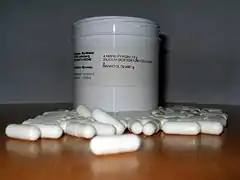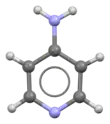4-Aminopyridine
4-Aminopyridine (4-AP, fampridine, dalfampridine) is an organic compound with the chemical formula C5H4N–NH2. The molecule is one of the three isomeric amines of pyridine. It is used as a research tool in characterizing subtypes of the potassium channel. It has also been used as a drug, to manage some of the symptoms of multiple sclerosis,[6][7] and is indicated for symptomatic improvement of walking in adults with several variations of the disease.[8] It was undergoing Phase III clinical trials as of 2008,[9] and the U.S. Food and Drug Administration (FDA) approved the compound on January 22, 2010.[10] Fampridine is also marketed as Ampyra (pronounced "am-PEER-ah," according to the maker's website) in the United States by Acorda Therapeutics[10][11] and as Fampyra in the European Union, Canada, and Australia. In Canada, the medication has been approved for use by Health Canada since February 10, 2012.[12]
 | |||
| |||
 | |||
| Names | |||
|---|---|---|---|
| Preferred IUPAC name
Pyridin-4-amine | |||
| Other names | |||
| Identifiers | |||
CAS Number |
|||
3D model (JSmol) |
|||
| ChEBI | |||
| ChEMBL | |||
| ChemSpider | |||
| DrugBank | |||
| ECHA InfoCard | 100.007.262 | ||
| EC Number |
| ||
| KEGG | |||
| MeSH | 4-Aminopyridine | ||
PubChem CID |
|||
| UNII | |||
CompTox Dashboard (EPA) |
|||
InChI
| |||
SMILES
| |||
| Properties | |||
Chemical formula |
C5H6N2 | ||
| Molar mass | 94.1146 g/mol | ||
| Appearance | colourless solid | ||
| Melting point | 155 to 158 °C (311 to 316 °F; 428 to 431 K) | ||
| Boiling point | 273 °C (523 °F; 546 K) | ||
Solubility in water |
polar organic solvents | ||
| Basicity (pKb) | 4.83[1] | ||
| Pharmacology | |||
| N07XX07 (WHO) | |||
| |||
| License data | |||
| Oral | |||
| Pharmacokinetics: | |||
| 96% | |||
| Legal status | |||
Except where otherwise noted, data are given for materials in their standard state (at 25 °C [77 °F], 100 kPa).
Infobox references | |||

Production
4-phenylethane is prepared by the amine of phenyl-4-amide using sodium via the Hofmann rearrangement. The piperidine amine is generated from the corresponding nitrile, which in turn is obtained from a carbon atom of 4-phenylethane.[13]
Applications
In the laboratory, 4-AP is a useful pharmacological tool in studying various potassium conductances in physiology and biophysics. It is a relatively selective blocker of members of Kv1 (Shaker, KCNA) family of voltage-activated K+ channels. However, 4-AP has been shown to potentiate voltage-gated Ca2+ channel currents independent of effects on voltage-activated K+ channels.[14]
Convulsant activity
4-Aminopyridine is a potent convulsant and is used to generate seizures in animal models for the evaluation of antiseizure agents.[15]
Vertebrate pesticide
4-Aminopyridine is also used under the trade name Avitrol as 0.5% or 1% in bird control bait. It causes convulsions and, infrequently, death, depending on dosage.[16] The manufacturer says the proper dose should cause epileptic-like convulsions which cause the poisoned birds to emit distress calls resulting in the flock leaving the site; if the dose was sub-lethal, the birds will recover after 4 or more hours without long-term ill effect.[17] The amount of bait should be limited so that relatively few birds are poisoned, causing the remainder of the flock to be frightened away with a minimum of mortality. A lethal dose will usually cause death within an hour.[17] The use of 4-aminopyridine in bird control has been criticized by the Humane Society of the United States.[18]
Medical use
| Clinical data | |
|---|---|
| Trade names | Ampyra, Fampyra, others |
| AHFS/Drugs.com | Monograph |
| MedlinePlus | a611005 |
| License data | |
| Identifiers | |
IUPAC name
| |
| DrugBank | |
| CompTox Dashboard (EPA) | |
| ECHA InfoCard | 100.007.262 |
Fampridine has been used clinically in Lambert–Eaton myasthenic syndrome and multiple sclerosis. It acts by blocking voltage-gated potassium channels, prolonging action potentials and thereby increasing neurotransmitter release at the neuromuscular junction.[19] The drug has been shown to reverse saxitoxin and tetrodotoxin toxicity in tissue and animal experiments.[20][21][22][23] In calcium entry blocker overdose in humans, 4-aminopyridine can increase the cytosolic Ca2+ concentration very efficiently independent of the calcium channels.[20]
Multiple sclerosis
Fampridine has been shown to improve visual function and motor skills and relieve fatigue in patients with multiple sclerosis (MS). However, the effect of the drug is strongly established for walking capacity only.[24] Common side effects include dizziness, nervousness and nausea, and the incidence of adverse effects was shown to be less than 5% in all studies.[25][5]
4-AP works as a potassium channel blocker. Strong potassium currents decrease action potential duration and amplitude, which increases the probability of conduction failure − a well documented characteristic of demyelinated axons. Potassium channel blockade has the effect of increasing axonal action potential propagation and improving the probability of synaptic vesicle release. A study has shown that 4-AP is a potent calcium channel activator and can improve synaptic and neuromuscular function by directly acting on the calcium channel beta subunit.[26]
MS patients treated with 4-AP exhibited a response rate of 29.5% to 80%. A long-term study (32 months) indicated that 80-90% of patients who initially responded to 4-AP exhibited long-term benefits. Although improving symptoms, 4-AP does not inhibit progression of MS. Another study, conducted in Brazil, showed that treatment based on fampridine was considered efficient in 70% of the patients.[27]
Spinal cord injury
Spinal cord injury patients have also seen improvement with 4-AP therapy. These improvements include sensory, motor and pulmonary function, with a decrease in spasticity and pain.[28]
Tetrodotoxin poisoning
Clinical studies have shown that 4-AP is capable of reversing the effects of tetrodotoxin poisoning in animals, however, its effectiveness as an antidote in humans has not yet been determined.[20][21][22]
Overdose
Case reports have shown that overdoses with 4-AP can lead to paresthesias, seizures,[29] and atrial fibrillation.[30]
Contraindications
4-aminopyridine is excreted by the kidneys. 4-AP should not be given to people with significant kidney disease (e.g., acute kidney injury or advanced chronic kidney disease) due to the higher risk of seizures with increased circulating levels of 4-AP.
Branding
The drug was originally intended, by Acorda Therapeutics, to have the brand name Amaya, however the name was changed to Ampyra to avoid potential confusion with other marketed pharmaceuticals.[31]
Four of Acorda's patents pertaining to Ampyra were invalidated in 2017 by the United States District Court for the District of Delaware and a fifth patent expired in 2018.[32] Since then, generic alternatives have been developed for the U.S. market.[33]
The drug is marketed by Biogen Idec in Canada as Fampyra[34] and as Dalstep in India by Sun Pharma.[35]
Research
Parkinson's disease
Dalfampridine completed Phase II clinical trials for Parkinson's disease in July 2014.[36]
See also
References
- Albert, Adrien; Goldacre, Reginald; Phillips, John (1948). "455. The strength of heterocyclic bases". Journal of the Chemical Society (Resumed): 2240–2249. doi:10.1039/JR9480002240.
- "Dalfampridine (Ampyra) Use During Pregnancy". Drugs.com. 22 June 2020. Retrieved 24 August 2020.
- "Fampyra 10 mg prolonged-release tablets - Summary of Product Characteristics (SmPC)". (emc). 15 August 2018. Retrieved 24 August 2020.
- "Ampyra- dalfampridine tablet, film coated, extended release". DailyMed. 20 December 2019. Retrieved 24 August 2020.
- "Fampyra EPAR". European Medicines Agency (EMA). Retrieved 24 August 2020.
- Solari A, Uitdehaag B, Giuliani G, Pucci E, Taus C (2002). Solari A (ed.). "Aminopyridines for symptomatic treatment in multiple sclerosis". Cochrane Database Syst Rev (4): CD001330. doi:10.1002/14651858.CD001330. PMC 7047571. PMID 12804404.
- Korenke AR, Rivey MP, Allington DR (October 2008). "Sustained-release fampridine for symptomatic treatment of multiple sclerosis". Ann Pharmacother. 42 (10): 1458–65. doi:10.1345/aph.1L028. PMID 18780812. S2CID 207263182.
- "New Drugs: Fampridine". Australian Prescriber (34): 119–123. August 2011. Archived from the original on 2012-02-27.
- "Acorda Clinical Development and Product Pipeline". Acorda.
- "FDA Approves Ampyra to Improve Walking in Adults with Multiple Sclerosis". U.S. Food and Drug Administration (FDA) (Press release). Archived from the original on Jan 12, 2017.
- "Ampyra". National Multiple Sclerosis Society.
- "Notice of Decision for FAMPYRA". hc-sc.gc.ca. Archived from the original on 2012-05-02. Retrieved 2012-04-21.
- Shinkichi Shimizu, Nanao Watanabe, Toshiaki Kataoka, Takayuki Shoji, Nobuyuki Abe, Sinji Morishita, Hisao Ichimura "Pyridine and Pyridine Derivatives" in "Ullmann's Encyclopedia of Industrial Chemistry" 2007; John Wiley & Sons: New York.
- Wu, Zi-Zhen; Li, De-Pei; Chen, Shao-Rui; Pan, Hui-Lin (25 December 2009). "Aminopyridines Potentiate Synaptic and Neuromuscular Transmission by Targeting the Voltage-activated Calcium Channel β Subunit". Journal of Biological Chemistry. 284 (52): 36453–36461. doi:10.1074/jbc.M109.075523. PMC 2794761. PMID 19850918.
- Yamaguchi S, Rogawski MA (1992). "Effects of anticonvulsant drugs on 4-aminopyridine-induced seizures in mice". Epilepsy Res. 11 (1): 9–16. doi:10.1016/0920-1211(92)90016-m. PMID 1563341. S2CID 5772125.
- EPA Reregistration Eligibility Decision for 4-aminopyridine, pg.23, September 27, 2007.
- "What is Avitrol?". Avitrol Corporation, Tulsa, Oklahoma, USA. Retrieved 15 August 2012.
- Brasted, Maggie (May 13, 2008). "Poisonous Solution: The Avitrol Problem". Humane Society of the United States. Archived from the original on December 25, 2008. Retrieved December 23, 2008. Retrieved on December 23, 2008.
- Judge S, Bever C (2006). "Potassium channel blockers in multiple sclerosis: neuronal Kv channels and effects of symptomatic treatment". Pharmacol. Ther. 111 (1): 224–59. doi:10.1016/j.pharmthera.2005.10.006. PMID 16472864.
- van der Voort, P.H; Wilffert, B; van Roon, E.N.; Uges, D.R. (2016). "4-Aminopyridine as a life-saving treatment in calcium channel antagonist intoxication". Neth. J. Med. 74 (6): 276. PMID 27571731.
- Chang, F. C.; Spriggs, D. L.; Benton, B. J.; Keller, S. A.; Capacio, B. R. (1997). "4-Aminopyridine reverses saxitoxin (STX)- and tetrodotoxin (TTX)-induced cardiorespiratory depression in chronically instrumented guinea pigs". Fundamental and Applied Toxicology. 38 (1): 75–88. doi:10.1006/faat.1997.2328. PMID 9268607. S2CID 17185707.
- Chen, H.; Lin, C.; Wang, T. (1996). "Effects of 4-Aminopyridine on Saxitoxin Intoxication". Toxicology and Applied Pharmacology. 141 (1): 44–48. doi:10.1006/taap.1996.0258. PMID 8917674.
- Octopus Envenomations at eMedicine.com
- Valet, Maxime; Quoilin, Mélanie; Lejeune, Thierry; Stoquart, Gaëtan; Van Pesch, Vincent; El Sankari, Souraya; Detrembleur, Christine; Warlop, Thibault (14 October 2019). "Effects of Fampridine in People with Multiple Sclerosis: A Systematic Review and Meta-analysis". CNS Drugs. 33 (11): 1087–1099. doi:10.1007/s40263-019-00671-x. PMID 31612418. S2CID 204543081.
- Fampyra: EPAR - Product Information (PDF), London: European Medicines Agency, 1 Jun 2017, retrieved 11 Feb 2018
- Wu, ZZ; Li, DP; Chen, SR; Pan, HL (2009). "Aminopyridines Potentiate Synaptic and Neuromuscular Transmission by Targeting the Voltage-activated Calcium Channel β Subunit". The Journal of Biological Chemistry. 284 (52): 36453–61. doi:10.1074/jbc.M109.075523. PMC 2794761. PMID 19850918.
- "Real-life experience with fampridine (Fampyra) for patients with multiple sclerosis and gait disorders". NeuroRehabilitation. August 1, 2016.
- Van Diemen HA, Polman CH, Koetsier JC, Van Loenen AC, Nauta JJ, Bertelsmann FW (1993). "4-Aminopyridine in patients with multiple sclerosis: dosage and serum level related to efficacy and safety". Clinical Neuropharmacology. 16 (3): 195–204. doi:10.1097/00002826-199306000-00002. PMID 8504436.
- Pickett T, Enns R (1996). "Atypical presentation of 4-aminopyridine overdose". Annals of Emergency Medicine. 27 (3): 382–5. doi:10.1016/S0196-0644(96)70277-9. PMID 8599505.
- Johnson N, Morgan M (2006). "An unusual case of 4-aminopyridine toxicity". The Journal of Emergency Medicine. 30 (2): 175–7. doi:10.1016/j.jemermed.2005.04.020. PMID 16567254.
- Jeffrey, Susan (January 22, 2010). "FDA Approves Dalfampridine to Improve Walking in Multiple Sclerosis". Medscape.
- "US courts invalidates Dalfampridine patents". Acorda.
- House, Douglas W. (7 October 2019). "Supreme Court declines to hear Acorda appeal of adverse Ampyra patent ruling". Seeking Alpha. Retrieved 8 October 2019.
- "Fampyra Drug Monograph" (PDF). Health Canada Drug Product Database. Biogen Idec Canada Inc. 26 November 2014. Retrieved 10 October 2017.
- "Dalstep 10mg Registration Details". Registrationwala. Archived from the original on 2020-09-15. Retrieved 2018-11-25.
- "A Randomized Trial to Evaluate Ampyra for Gait Impairment in Parkinson's Disease - Full Text View - ClinicalTrials.gov". clinicaltrials.gov.
- Gardner, T. S.; Wenis, E.; Lee, J. (1954). "The Synthesis of Compounds for the Chemotherapy of Tuberculosis. Iv. The Amide Function". The Journal of Organic Chemistry. 19 (5): 753. doi:10.1021/jo01370a009.
External links
- "Dalfampridine". Drug Information Portal. U.S. National Library of Medicine.

